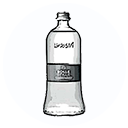For over a hundred years it has been the aperitif cocktail par excellence. Its recipe has been studied and revisited in many ways, but the classic Negroni remains one of the most loved cocktails in the world. For over a hundred years it has been the aperitif cocktail par excellence. Its recipe has been studied and revisited in many ways, but the classic Negroni remains one of the most loved cocktails in the world. Born in Florence in 1919, he has a really interesting story. It was in fact Count Camillo Negroni who had the idea of creating a cocktail that was similar to the Americano, but reinforced by gin. According to legend, the count would have gone to a young shop boy, Fosco Scarselli, who at the time worked in a grocery store in via de' Tornabuoni, Casoni, where the count loved to sit and drink his favorite drinks. Right here, returning from one of his trips, the count asked his friend for a change to his usual drink, a mix of bitters and red vermouth. He wanted it to be more robust, perhaps adding a distillate he had fallen in love with on his countless London trips, gin. Thus was born the Negroni. From Florence, the cocktail quickly spread under the name "Americano in the manner of Count Negroni", only to then take the simpler name Negroni over time. The ingredients of the Negroni We have said that the Negroni was born as an American cocktail, in which the soda was replaced by gin. Simple to make, it comes from the skilful blend of bitters, red Vermouth and gin. Bitter is a bitter, therefore a distillate which is then flavored in various ways, depending on the taste of who produces it. Far from the alcohol content of real distillates, it is a real aperitif liqueur. Not for nothing its most faithful lover in this aperitif is Vermouth, bitter but sweet at the same time. Composed of 75% wine, Vermouth is what the ancient Greeks called a "Hippocratic Wine", a wine-based drink to which ethyl alcohol is added, as well as various spices, aromatic herbs and aromas. The Vermouth used to mix the Negroni is the red one, a sweet Vermouth, made up of a quantity of sugar equal to or greater than 130 grams. The only Vermouth in which the use of caramel as a coloring is allowed, in this product the sweet taste is perfectly balanced by a herbaceous bittering note. The Negroni: traditional recipe To prepare the negroni, the secret is that it remains very simple as it is composed of 3 equal parts of: bitter, gin and a part of red vermouth, the latter, being a fortified and flavored wine, must be calibrated sparingly as it has a bitter, liqueury taste and contains a variable sugar content. The "Star" of Negroni: Gin Considering that gin is the distillate that contributed to the birth of the Negroni cocktail, it deserved a separate chapter. As you surely know, just like bitters and vermouths, each gin is different from the other and, based on the botanicals that characterize it, which will always give a different tone to your drink. Apium gin is a London dry with marked aromatic notes of lavender, which are combined with more classic botanicals such as juniper, rosemary, cubeb pepper, angelica, verbena, coriander. And finally, we too wanted to do our part. Negroni and gin Apium, a unique flavour, reinforced, as Count Camillo Negroni teaches us, with good gin. And here is our reinterpretation: 3 cl of Pallini red Bitter 3 cl of Apium gin 3 cl of Cocchi red Vermouth Slice of orange.

Added to the notepad



 Coffee bar (30)
Coffee bar (30)  Ice blend (2)
Ice blend (2)  Drinks (18)
Drinks (18)  Tea & herbal teas (4)
Tea & herbal teas (4)  Desserts (15)
Desserts (15)  Acheo drinks (6)
Acheo drinks (6)  Salted (13)
Salted (13)  Piccinino's dishes (9)
Piccinino's dishes (9)  Poke (5)
Poke (5)  Burgers (4)
Burgers (4)  PICCININO COCKTAIL LIST (5)
PICCININO COCKTAIL LIST (5)  Mocktails - non-alcoholic (11)
Mocktails - non-alcoholic (11)  Cocktails (35)
Cocktails (35)  Gin (20)
Gin (20)  Aperitif service (1)
Aperitif service (1)  Sparkling (6)
Sparkling (6)  White wines (10)
White wines (10)  Rosé wines (1)
Rosé wines (1)  Red wines (2)
Red wines (2)  Beers (12)
Beers (12)  Liqueurs and bitter (20)
Liqueurs and bitter (20)  Rum (6)
Rum (6)  Tequila/mezcal (2)
Tequila/mezcal (2)  Vodka (3)
Vodka (3)  Whiskey (3)
Whiskey (3)